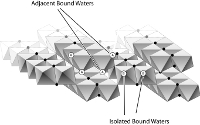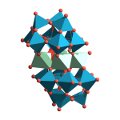189. Cooperation between bound waters
and hydroxyls in controlling isotope-exchange rates

Abstract: Water molecules bound to mineral oxides differ from aqueous ions in that they are usually attached to different metal centers, or vicinal, and thus separated from one another. In contrast, for most monomeric ions used to establish kinetic reactivity trends, such as octahedral aquo ions [e.g., Al(H2O)63+], the bound waters are closely packed, or geminal. Because of this structural difference, the existing literature about ligand substitution in monomer ions may be a poor guide to the reactions of geochemical interest. To understand how coordination of the reactive functional groups might affect the rates of simple water-exchange reactions, we synthesized two structurally similar Rh(III) complexes, [Rh(phen)2(H2O)2]3+[1] and [Rh(phen)2(H2O)Cl]2+[2] where (phen)=1,10-phenanthroline. Complex [1] has two adjacent, geminal, bound waters in the inner-coordination sphere and [2] has a single bound water adjacent to a bound chloride ion. We employed Rh(III) as a trivalent metal rather than a more geochemically relevant metal like Fe(III) or Al(III) to slow the rate of reaction, which makes possible measurement of the rates of isotopic substitution by simple mass spectrometry. We prepared isotopically pure versions of the molecules, dissolved them into isotopically dissimilar water, and measured the rates of exchange from the extents of 18O and 16O exchange at the bound waters.
The pH dependency of rates differ enormously between the two complexes. Pseudo-first-order rates coefficients at 298 K for water exchanges from the fully protonated molecules are close: ![]() = 5·10-8(± 0.5·10-8) s-1 for [1] and
= 5·10-8(± 0.5·10-8) s-1 for [1] and ![]() = 2.5·10-9(± 1·10-9) for [2]. Enthalpy and entropy activation parameters (ΔH‡ and ΔS‡) were measured to be 119(± 3) kJ mol-1, and 14(±1) J mol-1 K-1, respectively for [1]. The corresponding parameters for the mono-aquo complex, [2], are 132(±3) kJ mol-1 and 41.5(±2) J mol-1 K-1. Rates increase by many orders of magnitude upon deprotonation of one of the bound waters in complex [1] because of the close proximity of a transferable proton that can convert the bound hydroxyl to a bound water. This interconversion allows the oxygen to exchange as a bound water, rather than as a bound hydroxyl, which is slow at near-neutral pH conditions.
= 2.5·10-9(± 1·10-9) for [2]. Enthalpy and entropy activation parameters (ΔH‡ and ΔS‡) were measured to be 119(± 3) kJ mol-1, and 14(±1) J mol-1 K-1, respectively for [1]. The corresponding parameters for the mono-aquo complex, [2], are 132(±3) kJ mol-1 and 41.5(±2) J mol-1 K-1. Rates increase by many orders of magnitude upon deprotonation of one of the bound waters in complex [1] because of the close proximity of a transferable proton that can convert the bound hydroxyl to a bound water. This interconversion allows the oxygen to exchange as a bound water, rather than as a bound hydroxyl, which is slow at near-neutral pH conditions.
Panasci, A. F., McAlpin, J. G., Ohlin, C. A., Christensen, S., Fettinger, J. C., Britt, R. D., Rustad, J. R., Casey W. H. Cooperation between bound waters and hydroxyls in controlling isotope-exchange rates. Geochim. Cosmochim. Acta, 2011, In Press.








